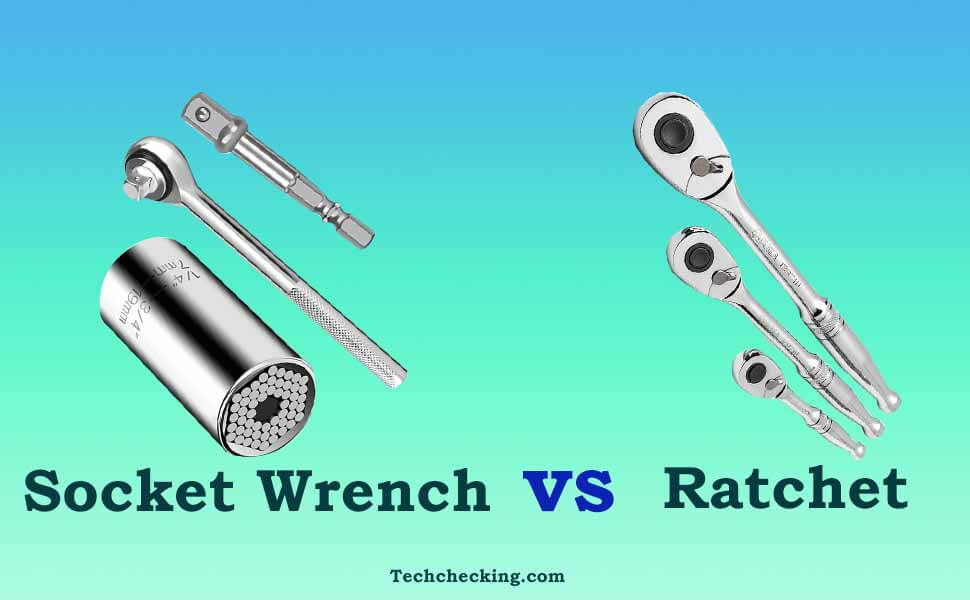If you are told to distinguish between a hammer and a wrench, you can do that without any confusion. But when it is about two types of wrenches especially socket wrench vs ratchet, you might get confused thinking about which one is what. Seeing no way when you start watching videos on YouTube to get the matter clear on socket wrench vs ratchet wrench, you may have some conceptions on it. However, it is true that without practical knowledge and experience, it is hard to differentiate between wrenches and ratchets. Are socket wrenches torque wrenches? A lot of questions such as these are spinning in your head, right? No worries, in this article we will try our level best to clear the conception between ratchet and socket wrench.
What is a Socket Wrench?
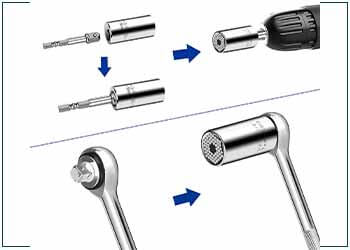
A socket wrench is one kind of wrench that features multiple interchangeable socket heads that can be attached by a socket arrangement to a ratcheting wrench handle or other drivers. The interchangeable socket heads are each designed to fit a particular size of the bolt head or other fasteners. You will find many socket sizes too.
In another way, a socket wrench also known as a spanner is a type of wrench that offers a socket attached at one end which is used to turn a fastener fasten or unfasten.
Wrenches can attach to fasteners in some specific ways. Well, if you talk about the traditional socket wrench, it can easily slip off the fastener because the open-end side allows sliding onto the fastener from the side.
In addition, these types of traditional socket wrench hardly work especially when it is in a tricky and hard-to-reach position.
Socket wrenches have sockets that play an important role by enclosing the fastener on all sides. And then it slides onto the fastener from the top. Once it’s properly set, the wrench doesn’t slip off as easily as you think because the wrench sticks to the fastener securely on all sides.
However, socket wrenches are prevalently hexagonal or double hexagonal that are commonly referred to as 6-point or 12-point box wrenches. Know different types of socket wrenches and their uses.
What is a Ratchet?
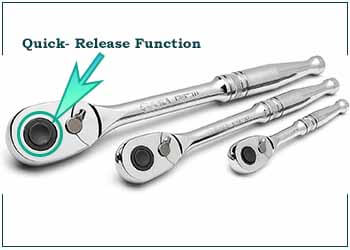
A ratchet, most prevalently known as a ratcheting socket wrench, is a kind of hand tool device that a metal handle is attached to a ratcheting mechanism, which attaches to a socket. Ratchets consist of a handle and a socket. Through the ratcheting mechanism, a socket is used to fit onto a type of nuts or bolts. Once the mechanism is properly set, pulling and pushing in one direction, the ratchet loosens or tightens the fastener that is attached to the socket.
In addition, the amazing part of a ratchet is that a ratchet doesn’t turn the socket and it only allows the ratchet handle to be re-positioned for another turn while staying attached to the bolt or nut.
Moreover, a switch built on a ratchet head is required to apply if users need to ratchet action in either direction. It means the switch is used to turn the ratchet counter-wise or anti-counter-wise in order to tighten or loosen nuts or bolts.
The mechanism of a ratchet saves a huge amount of time while working with a ratchet. Big lug nuts or bolts can be easily dealt with this type of ratchet.
Ratchet vs Socket Wrench – Key Differences
There are some key differences between ratchets and socket wrenches. They serve the same purpose but still, there are some differences between them.
| Features | Socket wrench | Ratchet |
| Size | Long | Small |
| Material | Metal | Metal |
| Handle | One | Doesn’t have any |
| Use | Tighten or loosen bolts | Tighten or loosen bolts |
| Attachment | Does not attach to anything | It is attached to a socket wrench |
Ratchet vs. Wrench Socket: Detailed Comparison
We have already pointed out the key features of a socket wrench and ratchet wrench. Now, we will discuss broadly them. Let’s now see the detailed comparison of the ratcheting socket wrench and wrench socket.
Size
There are different sizes of ratchets are available in the market. ¼ inch, 3/8 inch, and ½ inch are very common. You can find more sizes if you actually need them. However, ratchets use a gear drive in order to function. But when it is about gearless ratchets, they are usually jointed or have flex-head so that ratchets can easily access hard-to-reach places.
On the contrary, you can find also different sizes of wrench sockets. These sockets work by connecting with ratchets. So, different types of sockets are SAE sockets, metric sockets, impact sockets, Torx bit sockets, and others as well. You use one of them depending on the nature of the work you are doing.
Materials
Socket wrenches and ratchet of them are made of quality metal. There is a big difference in their material. Most sockets are made of oxide which protects sockets from corrosion and this is how the surface becomes new like always. And now speaking of the building materials of a ratchet, they are barely made of metal that has a possibility to get corroded.
So, we can deduce that some socket models are corrosion-proof due to their oxide materials while ratchets are not.
Compatibility
Socket heads are compatible with both breaker bars as well as wrenches. However, they can also work with ratchets by attaching them. So, smaller, medium, and large fasteners fit with the exact drive sockets accordingly. You can find sockets as well as wrench sizes in order to match the perfect one for the ratchet or wrench.
However, ratchets have attachments only to the gears that help them turn faster with fewer movements. In addition, some locks are effective that attach with ratchets more strongly. To be truthful, it also sticks with the fasteners even faster than geared drives.
Use
The geared drives have teeth that help with a slight swinging motion. Besides, there are also some gearless ratchets that feature roller bearings. The roller bearings need less movement to get the job done. Know more from here.
Socket Wrench vs Ratchet Wrench – which one to pick?
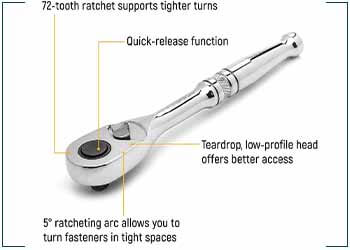
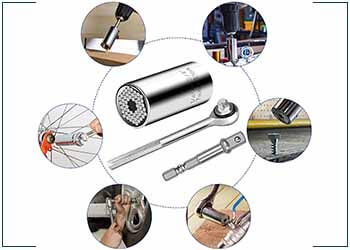
This is the most frequently asked question by beginners. Since they are new in this field, they have much to learn about socket wrench vs ratchet. Sometimes users get messed up understanding between the socket wrench and ratchet wrench. Many of us think socket wrenches and ratchet are completely different and are alternatives to one another. But, truth be told, those two tools can work as complementary tools to each other. You just need to know when and where to use the tools to get effective results for your work.
Yes, the building structure is different than one another but they serve the same purpose. What is the purpose then? Well, they are used to fasten or unfasten nuts and bolts. So if you take the point on their building mechanism, yes they are a bit different but it is true that they work for the same purposes.
Anyways, let’s talk about a real-life scenario. Suppose, you are working in a factory on an engine of a huge machine. You know the machine is built with many different sizes of nuts and bolts. In that case, to unfasten the fasteners sometimes you require a ratchet and sometimes a socket wrench as well. So, if you know much about ratchet vs socket wrench properly, you can just pick the right one. The common scenario is you are changing the wrenches frequently.
But what if you would know the best ways to use the right tool effectively without changing between them frequently, you certainly can save a lot of time. We all know, dealing with the nuts and bolts can truly be time-consuming but once you know and have the true skills, this doesn’t have to. So, acquiring proper knowledge and skills with a lot of practice can help you decide which one is the perfect tool to tighten or loosen nuts or bolts. This is why learning well ratchet vs socket wrench would be the best way to find out the best output you need.
Finally, you understand by now, there is no straight answer to this particular question – which one is better socket wrench or ratchet? Knowing and practicing a lot, you will know sometime the best answer and utilize socket wrench vs ratchet. So, while working pick the one it makes easier to get your job done quickly, effectively, and efficiently.
Torque Wrench vs Ratchet – Which one to pick?
However, there are some differences in the work process of ratchet vs torque wrench and you should learn about it too. For instance, if you need to tighten or specific pressure on a nut or bolt where a bit mismatch can make a crucial result, definitely in those cases, you must have to use a torque wrench. But while you are doing simple mechanic tasks, a ratchet will be an ideal pick.
When to Use Torque Wrenches Instead of Ratchets
If you apply incorrect torque on lug nuts or any important nuts on any vehicle, bad things may happen. For example, if you ever felt your car’s brake pedal underfoot, you have to understand that an improperly torqued lug nut is causing this problem. You may know, incorrectly tightened lug nuts put uneven pressure on a car’s brake rotor. So, when the rotor heats up, the car stops. How does this happen? Well, the uneven pressure causes uneven expansion of the rotor and unexpected incident happens.
So, how do correctly tighten the lug nuts? You can use torque wrenches because you can set the proper lbs. according to your need. You will be warned when you reach your desired torque power and you can stop then. So, using a torque wrench would be your solution instead of using ratchets all the time.
Generally, you can use torque wrenches for:
- Heavy-duty Applications: one of the most important jobs is tightening the fasteners of any heavy-duty vehicles. Any looseness of a fastener of heavy-duty equipment such as overhead cranes, locomotives, or any big machinery can potentially damage the parts which may lead to serious injury.
- High Precision Fastening: there are some fields such as medical devices, electronic devices, and sometimes other high-precision manufacturing fields, and tolerances are literally microscopic. So, even a slight over or under-tightening of a fastener can be crucial. It can cause a device unsafe.
Final Words
Socket wrench vs ratchet is an important topic to discuss. We have tried our best to make you understand the ratchet vs socket wrench. If you are a newbie, you will understand and know which one to pick when. Professional knows it and this is how they can save time a lot. Practice to accelerate skill as well as acquire knowledge can make you a better one.
So, the right size of a socket wrench with the right size of a ratchet must make your work done easily, quickly, and efficiently. So, what you need to do is always focus on your project’s requirements first and choose the best-suited tool. Gradually you would be a master of picking the right tools and can save a lot of time by doing the work quickly and efficiently.
Articles You May Like –
- How To Measure Socket Drive Size
- Monkey Wrench vs Pipe Wrench
- How to Use a Socket Wrench
- SAE Vs Metric Sockets
- 3/8 Vs 1/2 Impact Wrench

